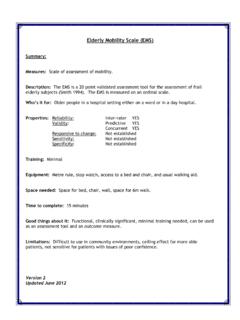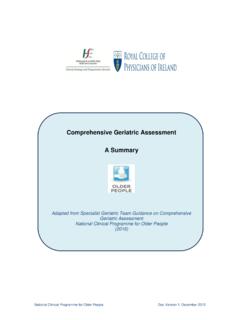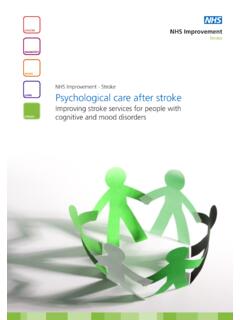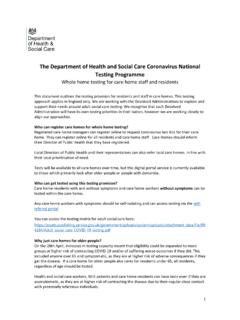Transcription of Guidelines for the Physiotherapy management of older ...
1 1 Guidelines for the Physiotherapy management of older people at risk of falling AGILE: Chartered Physiotherapists working with older people Produced by the AGILE Falls Guidelines working group: Victoria Goodwin & Louise Briggs August 2012 2 Since the publication of the Guidelines for the rehabilitative management of elderly people who have fallen 1 there has been a wealth of new research evidence, national and international Guidelines relating to the prevention of falls in older people . This update to the Guidelines is intended to provide a Physiotherapy focussed summary of the current evidence and to supplement Chartered Society of Physiotherapy and AGILE Standards of Practice. Evidence supports the provision of Physiotherapy interventions, such as exercise, as part of a uni-professional service, or, as part of a multi-disciplinary team, undertaking multi-factorial assessments and tailored interventions.
2 Practice points to consider: Establish the extent to which older people and their carers are able to participate in a falls prevention programme. Establish baselines of appropriate outcome measures as part of a pre-intervention assessment, against which ongoing or post-interventions outcome scores can be compared. This will enable an evaluation of the impact of any interventions, taking into account other plausible explanations for observed changes over time. Patient goal setting (as opposed to therapy goals) should form part of any rehabilitation programme. Short and longer term SMART goals should be identified (Specific, Measurable, Achievable, Realistic, Timed). Physiotherapists should employ strategies for o motivating older people to actively participate in rehabilitation programmes, and o promoting adherence, whilst taking into consideration patient beliefs, attitudes and preferences2.
3 When planning falls prevention programmes, supplementary interventions for bone health should also be considered for those older people at risk of fragility fracture, such as bone loading exercises, nutrition and medication. This may involve other members of the multi-disciplinary team or fracture liaison service. The provision of mobility aids should not be undertaken in isolation and should always form part of a broader rehabilitation programme including strength and balance training. Where current evidence for the effectiveness of interventions is inconclusive or absent, physiotherapists should make clinical decisions relating to the care of an individual patient based upon the best available evidence, in conjunction with contextual factors and information obtained during subjective and objective assessment of the individual.
4 3 Aim 1: To prevent falls Assessment including outcome measurement older people should be routinely asked whether they have fallen in the past year and asked about the frequency, context and characteristics of any falls2. management In a Cochrane systematic review, multi-component exercise programmes (home and group delivered) and Tai Chi have been found to reduce falls among community-dwelling older people3. Exercise programmes may be delivered as a single intervention or as part of a multi-factorial intervention. Programmes should be delivered by qualified health professionals or exercise professionals, tailored to the individual, and, should include regular review, progression and adjustment of the exercise prescription as appropriate4. Systematic reviews by Sherrington and colleagues regarding exercise interventions to reduce falls reported the most effective programmes included a high balance challenge, used a higher dose of exercise (50 hours- roughly twice a week for six months) and did not include a walking programme5;6.
5 The effectiveness of exercise interventions for preventing falls among people with stroke7 and Parkinson s disease8 is inconclusive. Neither exercise nor multi-factorial interventions appear to be effective at reducing falls among people with cognitive impairment4. In nursing care facilities, the effectiveness of exercise interventions is uncertain although supervised exercise programmes are effective in sub-acute hospital settings9. Multi-factorial interventions (which may include exercise) appear to be effective at reducing hospital falls and may be effective with people in nursing homes9. Key messages Assess falls history over the past year Exercise interventions can be delivered as a single intervention or as part of a multifactorial intervention Exercise programmes to reduce falls should be high dose (> 50 hours over 6 months) Exercise programmes to reduce falls should have a high balance challenge component 4 Aim 2: To improve the older person s ability to withstand threats to their balance Balance impairment is a major risk factor for falls among older people and those with long term conditions, such as stroke or Parkinson s disease10;11.
6 Assessment including outcome measurement older people reporting a fall or considered at risk of falling should be observed for balance and gait deficits and considered for their ability to benefit from interventions to improve strength and balance4. Assessment should identify risk factors relating to balance and mobility limitations, such as muscle strength and gait, and establish which factors are modifiable with exercise or rehabilitation interventions. There are a wide range of outcome measures for assessing balance. When selecting an outcome measure, consideration should be taken in relation to the properties of the measure (reliability, validity, sensitivity to change). Measures you may consider include: Berg Balance Scale Timed Up and Go Test Performance-Orientated Mobility Assessment 180 degree turn Four-square step test management A recent Cochrane systematic review12 examining exercise interventions to improve balance among older people reported exercise interventions that included: (a) gait, balance, coordination and function training; (b) strength training; (c) three dimensional training dance, tai chi; and (d) mixed training were beneficial in relation to balance outcomes.
7 The most effective programmes involved dynamic exercise programmes that ran three times weekly training for three months. Key messages Use appropriate reliable and valid outcome measures Include exercise components for gait, balance, coordination and function Include strength training and three dimensional activities Ensure balance training is sufficiently dynamic 5 Aim 3: To prevent the consequences of a long lie Up to half of non-injured fallers are unable to get up again13;14. The inability to get up from the floor independently following a fall is associated with subsequent serious fall-related injury15;16 and increased mortality14. The consequences of a long lie on the floor (> 1 hour) include pressure sores, hypothermia and dehydration and increased risk of admission to hospital with a subsequent fall, or moving into long term care17. In a national UK audit only 4% of fallers were taught how to get up again18.
8 Assessment including outcome measurement older people and their carers should be asked: If they are able to get up from the floor following a fall; How they move around on the floor, and keep warm; How they are able to get help. Those that report they are able to get up should be observed doing so. management with supporting evidence (including quality of evidence) There is some evidence that teaching and practicing how to get up from the floor is acceptable to older people and can be successful19;20. Key messages Ask all older people if they are able to get up from the floor following a fall Check that older people have a strategy to get help if they fall and are unable to rise Teach and practice how to get up from the floor, when possible 6 Aim 4: To optimise confidence and reduce fear of falling Fear of falling affects many older people , including those that have not experienced a fall.
9 This can lead to activity avoidance, loss of independence and reduced quality of life, and is associated with an increased risk of falling. These psychological factors can be more disabling and have a greater impact on function than the fall itself and should therefore be an important consideration in rehabilitation programmes. Assessment including outcome measurement Assessment should identify fall-related psychological factors that impact on confidence, activity restriction and participation. An appropriate outcome measure should be used such as the Falls Efficacy Scale (FES), FES - International (FES-I) or the Short FES-I. Each of these has been found to be a valid and reliable measure with cognitively intact older people and those with mild to moderate cognitive impairment. These measures are also responsive to change following interventions. Considerations when selecting a measure should include: How the measure will be administered (self-completed or by interview) as this will impact upon response rates.
10 Also, both the FES and the Short FES-I have been reported to have ceiling effects with more active older people . management with supporting evidence (including quality of evidence) There is high quality evidence from two systematic reviews supporting the benefits of interventions to improve confidence and reduce fear of falling21;22. Effective interventions are: exercise (including Tai Chi), hip protectors and multi-factorial falls prevention programmes. Key messages Assess for fall-related psychological factors Use an appropriate outcome measures such as the FES-I Consider interventions such as exercise and Tai Chi 7 Reference List (1) Simpson JM, Harrington R, Marsh N. Managing falls among elderly people . Physiotherapy 1998; 84:173-177. (2) national Institute for Health and clinical Excellence. Falls: The assessment and prevention of falls in older people .







